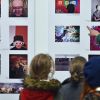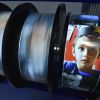Creative alertness
Trevor Paglen’s comprehensive retrospective at the Frankfurter Kunstverein.

In the face of global surveillance on a gigantic scale – something that few people can technically grasp and many condemn for moral reasons – what is there left for citizens to do? Should we just resign ourselves? Accept our powerlessness? The US photographer Trevor Paglen offers a different answer. In order to document secret-service practices, he joins forces with scientists, amateur astronomers, programmers and human-rights activists to conduct broadly based research. The resulting works of art were first shown in a comprehensive retrospective at the Frankfurter Kunstverein from June to August 2015. During the exhibition Paglen was awarded the Cultural Award of the German Photographic Association.
For all their political background, Paglen’s photographs exude by an enigmatic beauty – like the surveillance satellite he had tracked down in the luminous, reddish starry sky, or the night-time photograph of a communications intercept station in the woods of West Virginia, shot with a time exposure: a green sea of trees surrounding the lonely twinkling electric lights of the listening post. Paglen leaves us in no doubt about his critical attitude to these surveillance practices. This was illustrated by the Autonomy Cube at the Frankfurt exhibition developed by him and the internet activist Jacob Appelbaum. The sculpture offers a WiFi hotspot enabling users to browse the internet via the Tor network, which ensures the anonymity of the connection data.
“Is this a new form of art? Or a new form of journalism? Or perhaps even more: a possible future model for investigative research?” These three questions were formulated by art historian Julia Voss, deputy head of the feature section of the “Frankfurter Allgemeine Zeitung”, after seeing the exhibition. The answer to all three questions is probably yes. Voss also referred to the traditionally close relations between the art associations and civic engagement organizations. Trevor Paglen’s works, too, would be impossible without the involvement of many people. The Tor network used by the Autonomy Cube, for example, is also supported by thousands of servers operated on a voluntary basis.
Trevor Paglen also launched a photog- raphy contest in Frankfurt. Everyone was invited to document evidence of surveillance – by everything from the base stations of the US National Security Agency and the German Federal Intelligence Service (BND) to individual security cameras. The project met with considerable resonance: the winning works were shown at Paglen’s exhibition, and all the competition entries were compiled in a dossier. ▪

